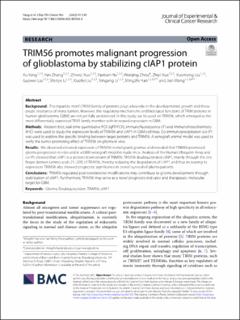| dc.contributor.author | Yang, Xu | |
| dc.contributor.author | Zhang, Yan | |
| dc.contributor.author | Xue, Zhiwei | |
| dc.contributor.author | Hu, Yaotian | |
| dc.contributor.author | Zhou, Wenjing | |
| dc.contributor.author | Xue, Zhiyi | |
| dc.contributor.author | Liu, Xuemeng | |
| dc.contributor.author | Liu, Guowei | |
| dc.contributor.author | Li, Wenjie | |
| dc.contributor.author | Liu, Xiaofei | |
| dc.contributor.author | Li, Xingang | |
| dc.contributor.author | Han, Mingzhi | |
| dc.contributor.author | Wang, Jian | |
| dc.date.accessioned | 2023-03-13T12:28:19Z | |
| dc.date.available | 2023-03-13T12:28:19Z | |
| dc.date.created | 2022-12-19T09:53:05Z | |
| dc.date.issued | 2022 | |
| dc.identifier.issn | 1756-9966 | |
| dc.identifier.uri | https://hdl.handle.net/11250/3057949 | |
| dc.description.abstract | Background
The tripartite motif (TRIM) family of proteins plays a key role in the developmental growth and therapeutic resistance of many tumors. However, the regulatory mechanisms and biological functions of TRIM proteins in human glioblastoma (GBM) are not yet fully understood. In this study, we focused on TRIM56, which emerged as the most differentially expressed TRIM family member with increased expression in GBM.
Methods
Western blot, real-time quantitative PCR (qRT-PCR), immunofluorescence (IF) and immunohistochemistry (IHC) were used to study the expression levels of TRIM56 and cIAP1 in GBM cell lines. Co-immunoprecipitation (co-IP) was used to explore the specific binding between target proteins and TRIM56. A xenograft animal model was used to verify the tumor promoting effect of TRIM56 on glioma in vivo.
Results
We observed elevated expression of TRIM56 in malignant gliomas and revealed that TRIM56 promoted glioma progression in vitro and in a GBM xenograft model in nude mice. Analysis of the Human Ubiquitin Array and co-IPs showed that cIAP1 is a protein downstream of TRIM56. TRIM56 deubiquitinated cIAP1, mainly through the zinc finger domain (amino acids 21–205) of TRIM56, thereby reducing the degradation of cIAP1 and thus increasing its expression. TRIM56 also showed prognostic significance in overall survival of glioma patients.
Conclusions
TRIM56-regulated post-translational modifications may contribute to glioma development through stabilization of cIAP1. Furthermore, TRIM56 may serve as a novel prognostic indicator and therapeutic molecular target for GBM. | en_US |
| dc.language.iso | eng | en_US |
| dc.publisher | BMC | en_US |
| dc.rights | Navngivelse 4.0 Internasjonal | * |
| dc.rights.uri | http://creativecommons.org/licenses/by/4.0/deed.no | * |
| dc.title | TRIM56 promotes malignant progression of glioblastoma by stabilizing cIAP1 protein | en_US |
| dc.type | Journal article | en_US |
| dc.type | Peer reviewed | en_US |
| dc.description.version | publishedVersion | en_US |
| dc.rights.holder | Copyright 2022 The Author(s) | en_US |
| dc.source.articlenumber | 336 | en_US |
| cristin.ispublished | true | |
| cristin.fulltext | original | |
| cristin.qualitycode | 1 | |
| dc.identifier.doi | 10.1186/s13046-022-02534-8 | |
| dc.identifier.cristin | 2094993 | |
| dc.source.journal | Journal of Experimental & Clinical Cancer Research | en_US |
| dc.identifier.citation | Journal of Experimental & Clinical Cancer Research. 2022, 41, 336. | en_US |
| dc.source.volume | 41 | en_US |
| dc.source.issue | 1 | en_US |

